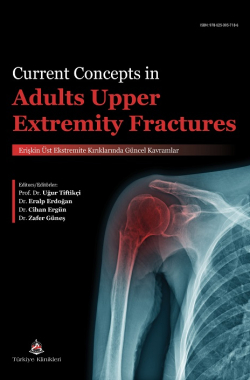EMERGENCY MANAGEMENTOF HUMERAL DIAPHYSEAL FRACTURES
Enes Oğuz
Ankara Training and Research Hospital, Department of Orthopedics and Traumatology, Ankara, Türkiye
Oğuz E. Emergency Management of Humeral Diaphyseal Fractures. In: Tiftikçi U, Erdoğan E, Ergün C, Güneş Z, editors. Current Concepts in Adults Upper Extremity Fractures. 1st ed. Ankara: Türkiye Klinikleri; 2025. p.77-83.
ABSTRACT
Fractures of the Humeral Shaft are common injuries following trauma and require urgent intervention. The management of such fractures begins with stabilizing the patient’s overall condition and necessitates a multidisciplinary approach. During the initial assessment phase, the patient’s vital signs should be evaluated, and the ABC (Airway, Breathing, Circulation) protocol should be applied to determine the urgency of the situation. Humeral shaft fractures can occur as isolated injuries or in conjunction with polytrauma. Therefore, understanding the mechanism of injury and ruling out other potential injuries is of critical importance. High-energy traumas (e.g., motor vehicle accidents and falls from height) and low-energy traumas (particularly simple falls in elderly patients) are the primary causes of these fractures.
The physical examination should include a detailed assessment of pain, swelling, deformity and limitation of movement at the fracture site. In addition, the neurovascular examination should be meticulous because of the high risk of damage to the nerve and vascular structures around the humerus. Radiological assessment usually begins with anteroposterior and lateral radiographs, and this imaging modality is usually sufficient. In addition, advanced imaging modalities such as computed tomography and magnetic resonance imaging may be used to identify other pathologies.
In emergency intervention, rapid immobilization of the fracture and control of pain are of great importance. Temporary immobilization should be performed to ensure the stability of the fracture fragments and to prevent complications. Pain management should be carried out with non-steroidal anti-inflammatory drugs (NSAIDs) and opioids. In open humeral diaphyseal fractures, wound care, antibiotic therapy, and surgical intervention are vital due to the risk of infection.
The most common complications are radial nerve injuries and compartment syndrome. Nerve injuries may occur as a result of direct trauma or damage to the nerve by fracture ends and usually heal within 6-12 weeks. Compartment syndrome is a condition in which soft tissues in the extremity are damaged due to high pressure and requires emergency fasciotomy. Vascular injuries may occur rarely and require urgent surgical repair as they may lead to severe ischaemic complications.
Keywords: Humeral diaphyseal fractures; Emergency management; Complications; Nerve injuries; Compartment syndrome; Open fractures
Kaynak Göster
Referanslar
- ATLS Subcommittee; American College of Surgeons' Committee on Trauma; International ATLS working group. Advanced trauma life support (ATLS®): the ninth edition. J Trauma Acute Care Surg. 2013 May;74(5):1363-6. [Crossref]
- Court-Brown, CM, et al. Trauma. Rockwood and Green's Fractures in Adults, 8th ed., Philadelphia: Wolters Kluwer. 2017.
- Shao Y, et al. Radial Nerve Palsy Associated with Fractures of the Humeral Shaft: A Systematic Review. Journal of Bone and Joint Surgery. 2005;87(3):577-585. [Crossref] [PubMed]
- Koval KJ, Zuckerman JD. Fractures of the Humeral Shaft. New York: Springer. 2014.
- Bhandari M, Swiontkowski M. Management of Fractures. BMJ. 2016;352:i1251.
- Sarmiento A, Latta LL. Functional fracture bracing. J Am Acad Orthop Surg. 1999;7(1):66-75. [Crossref] [PubMed]
- Sanders DM. Orthopaedic Cast and Splint Techniques. New York: Springer, 2022.
- Norden CW. Antibiotic prophylaxis in orthopedic surgery. Rev Infect Dis. 1991 Sep-Oct;13 Suppl 10:S842-6. [Crossref] [PubMed]
- Livani B, Belangero WD. Treatment of humeral shaft fractures with minimally invasive percutaneous plate osteosynthesis. Journal of Orthopaedic Trauma. 2004.
- Holstein A, Lewis G. Fractures of the Humeral Shaft with Radial Nerve Palsy. Journal of Bone and Joint Surgery. 1963;45(7):1382-1388. [Crossref]
- Shao Y, et al. Radial Nerve Palsy Associated with Fractures of the Humeral Shaft: A Systematic Review. Journal of Bone and Joint Surgery, 2005;87(3):577-585. [Crossref] [PubMed]
- Shao YC, Harwood P, Grotz MR, Limb D, Giannoudis PV. Radial nerve palsy associated with fractures of the shaft of the humerus: a systematic review. J Bone Joint Surg Br. 2005 Dec;87(12):1647-52. [Crossref] [PubMed]
- Korompilias AV, Lykissas MG, Kostas-Agnantis IP, Vekris MD, Soucacos PN, Beris AE. Approach to radial nerve palsy caused by humerus shaft fracture: is primary exploration necessary? Injury. 2013 Mar;44(3):323-6.23352153. [Crossref] [PubMed]
- Court-Brown CM, et al. Rockwood and Green's Fractures in Adults. Lippincott Williams & Wilkins. 2017.

